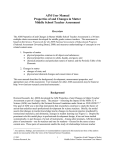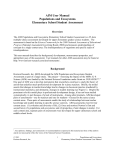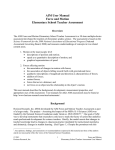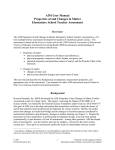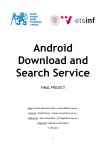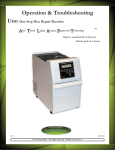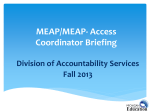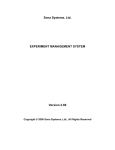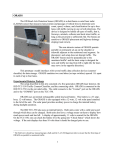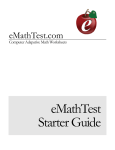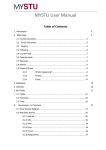Download AIM Populations and Ecosystems
Transcript
AIM User Manual Populations and Ecosystems Middle School Student Assessment Overview The AIM Populations and Ecosystems Middle School Student Assessment is a 30-item multiplechoice assessment developed for middle grades science students. The assessment is based on the Science Framework for the 2009 National Assessment of Educational Progress (National Assessment Governing Board, 2008) and measures understandings of concepts in related single content area: the interdependence of organisms and specific types of interdependence. This user manual describes the background, development, measurement properties, and appropriate uses of the assessment. User manuals for other AIM assessments may be found at http://www.horizon-research.com/aim/instruments/. Background Horizon Research, Inc. (HRI) developed the AIM Populations and Ecosystems Student Assessment as part of a larger study. The project—Assessing the Impact of the MSPs: K–8 Science (AIM) was funded by the National Science Foundation under Grant no. DUE-0928177.1 One goal of AIM was to develop instruments that researchers could use to study the theory of action that underlies much professional development for science teachers. Briefly, the model asserts that changes in teacher knowledge lead to changes in classroom practice (mediated by instructional materials), and ultimately, changes in student learning (see Figure 1). Despite the prominent role this model plays in professional development design, it has not been studied systematically, in part because of a lack of instruments. Among other products, AIM developed pairs of assessments—one for teachers and one for students—focused on the same science content areas. These pairs of assessments enable the study of relationships between teacher knowledge and student learning in specific science contexts. AIM assessments exist for four content areas: (1) evolution and diversity of life; (2) force and motion (Newton’s first and second laws); (3) populations and ecosystems; and (4) properties of and changes in matter. For each content area, separate pairs of assessments were developed for elementary school and middle school levels. 1 Any opinions, findings, and conclusions or recommendations expressed in this material are those of the authors and do not necessarily reflect the views of the National Science Foundation. © 2013 Horizon Research, Inc. 1 Populations and Ecosystems Middle School Student Assessment User Manual Professional Development Theory of Action Professional Development Improved Teacher Content Knowledge for Science Teaching Improved Classroom Practice Increased Student Achievement Instructional Materials Figure 1 To enable large-scale research, HRI set out to create assessments that would be minimally burdensome, both for the test-taker and the researcher. Accordingly, HRI opted for a multiplechoice format, recognizing the limitations of such items. For instance, well-constructed, openended items may probe more depth of understanding than multiple-choice items, but they are more burdensome for both the researcher (in terms of scoring costs) and the test-taker (in terms of time required to complete the assessment). In addition, scoring open-ended items requires the training of raters to establish inter-rater reliability. Development of the Populations and Ecosystems Middle School Student Assessment As described above, this development effort was part of a much larger and well-funded project, which afforded a thorough development process (see Figure 2). © 2013 Horizon Research, Inc. 2 Populations and Ecosystems Middle School Student Assessment User Manual Assessment Development Process Three Ph.D.s in content area unpack and clarify the science content to be assessed Write multiple choice items Collaborative item editing Conduct cognitive interviews with teachers/students Revise items Review by a Ph.D. in content area Pilot multiple choice items with teachers/students Conduct IRT analyses and construct scale Figure 2 Clarifying the Content Domain Development began with identifying the target content for the populations and ecosystems assessments. We used the 2009 NAEP Framework for direction on the content of the AIM assessments. The NAEP Framework was based primarily on the National Science Education Standards (National Research Council, 1996) and the Benchmarks for Science Literacy (American Association for the Advancement of Science, 1993), but also reflected developments in science and policy that have taken place since those documents were published. HRI specified the assessment domain using a single strand in the NAEP Framework: the interdependence of organisms and specific types of interdependence. This process had three biologists/biology educators “unpack” the content into series of “sub-ideas” for middle school students. These are the ideas that were considered in developing the middle school student assessment. The final description of the content domain is shown in Table 1. © 2013 Horizon Research, Inc. 3 Populations and Ecosystems Middle School Student Assessment User Manual Table 1 Populations and Ecosystems Content Domain Populations and Ecosystems. The interdependence of organisms and specific types of interdependence Sub-ideas for students: Organisms interact and are interdependent in various ways, including providing food and shelter to one another. o An organism is any living thing, such as a plant or an animal. Organisms are categorized by how they get their food. o Organisms depend on other organisms for food and/or nutrients. o In some interactions, both organisms benefit by interacting and are more likely to survive and reproduce. o In some interactions, one organism will benefit by interacting and is more likely to survive and reproduce while the other is harmed and its survival and/or reproduction may be limited. Organisms can survive only in environments in which their needs are met. o Each type of organism has a specific range of environmental conditions under which it can survive. Environmental conditions include, but are not limited to, temperature, moisture, amount of oxygen, nutrient availability, and salinity. Some interactions are beneficial; others are detrimental to the organism and other organisms. When the environment changes, some plants and animals survive and reproduce; others die or move to new locations. o An organism’s environment includes all of the living and non-living things that surround and influence the organism. o Organisms have different traits; some traits are better than others for a given environment (i.e., help the organism meet its needs). o Organisms with traits that are favorable in an environment are more likely to survive and reproduce, whereas organisms that lack those traits are less likely to survive and reproduce. o Organisms, including humans, often change the environment in which they live through feeding, leaving waste, and/or competing with other organisms. o Sometimes, environments change and no longer provide for the needs of some or all of the organisms that live there. Some organisms will be able to survive in the new conditions, some will move to a new environment where their needs are met, and some will not survive. Two types of organisms may interact with one another in several ways: They may be in a producer/consumer, predator/prey, or parasite/host relationship. Or, one organism may scavenge or decompose another. o Producers, including green plants and algae, are the primary food source within an ecosystem. o Food webs illustrate the feeding relationships between producers and consumers and among consumers in an ecosystem. Relationships may be competitive or mutually beneficial. Some species have become so adapted to each other that neither could survive without the other. o Sometimes, organisms compete with each other for food and resources. o Competitive relationships exist when multiple organisms rely on the same resource(s). o Mutually beneficial relationships (mutualisms) exist when organisms interact and both or all are more likely to survive and/or reproduce. o Co-evolution occurs when more than one species have existed together long-term, influencing changes in each other. The number of organisms and populations an ecosystem can support depends on the biotic resources available and abiotic factors, such as quantity of light and water, range of temperatures, and soil composition. o All populations living together and the physical factors with which they interact compose an ecosystem. o A population is a group of individuals of the same species that live and breed together in a particular area. o Organisms compete for limited resources. Populations of organisms can potentially grow unchecked, but tend to remain the same size because of limited resources. o When organisms compete, often only some organisms survive because they are better adapted for acquiring resources in that environment. o Population density in an area varies from time to time based on variation in availability of nutrients, weather, and presence of other organisms. All organisms cause changes in the environment where they live. Some of these changes are detrimental to the organisms or other organisms, whereas others are beneficial. o The mix of species in a given environment changes in response to a changing environment over time. o Ecological succession occurs in areas where there have previously been no organisms (e.g., weathering rock) or where prior life has been removed or reduced (e.g., volcanoes, fire). Pioneer organisms change the environment in ways that make it possible for other organisms that could not previously survive in the environment to live there. Organisms successively change the environment, making it more suitable for other organisms. o Some organisms can change their environment to the extent that their offspring can no longer live there. This area becomes better suited to other organisms. o Non-native organisms introduced into a new area may outcompete, overeat, and/or replace native organisms, resulting in significant environmental changes. o An ecological niche is the role that an organism plays in its environment. An organism’s niche includes the resources it uses from the environment and how it acquires and uses those resources. o No two species can occupy the same niche at the same time (competitive exclusion principle). Competition between two species sometimes leads to increased niche specialization (resource partitioning), thereby permitting coexistence of multiple species. o An adaptation is a physical or behavioral trait of an individual that enhances its chances of surviving and reproducing in an environment. The development of an adaptation does not occur within the lifetime of an organism, but only within populations (and across generations). o Individuals of a species or population have variation in their traits. Natural selection refers to the selection by the environment (selective pressure) of those traits that promote survival and reproduction better than others. (Natural selection acting on heritable traits results in the survival of organisms that are more suited to a particular environment.) © 2013 Horizon Research, Inc. 4 Populations and Ecosystems Middle School Student Assessment User Manual Item Development HRI staff drafted items individually then met to edit them collaboratively. As the pool of items grew, we began recruiting middle school students for telephone cognitive interviews. We typically interviewed three students on each item in the pool using the interview protocol shown in Figure 3. After a round of interviews, HRI staff met to discuss students’ responses and feedback. If substantive edits were made to an item, we interviewed additional students about the revised version. When interviews suggested no further edits were needed, we asked a content expert to review all of the items in the pool for content accuracy. AIM Student Assessment Items Cognitive Interview Protocol Prologue Script: We are developing test questions for middle school students who have been studying populations and ecosystems, and we need your help to get the questions just right. I realize that you may not have studied some of this yet in school, and I don’t expect you to get all of the answers right. If you get a few wrong, it will help me know whether we have written the answer choices well. You can ask me to explain any words or situations that may be unfamiliar or confusing, but I can’t give you the answer to any of the questions until the end of the interview. Remember, the point is to help us write a good test, not to test what you do or don’t know. You won’t get a grade or anything like that on the test. Do you have any questions before we get started? If at any point in the interview you would like to stop, just say so. Procedure: Ask student to read aloud and “think aloud” as they read the questions and answer choices, if they are comfortable doing so. Remind the student to go back and reread the question to himself/herself if he/she needs to. If reading the question aloud is too distracting or uncomfortable, allow the student to read the question to himself/herself. It is not necessary to time how long it takes for the student to arrive at an answer, but if it takes an especially long time on a question, please make a note of it in the comment area of the notes. For each item, ask: 1. Why did you choose that answer? (probe for words or diagrams they keyed in on, as well as their thinking behind the response) 2. What did you think of each of the other answer choices? 3. Was there an answer choice you were expecting to see, but did not? What was it? 4. Were there any words or diagrams you did not really understand, or situations that made the question confusing? 5. Is there anything about the question that did not confuse you, but that you think might confuse other students? 6. Do you have any other comments on the item? Figure 3 An example student assessment item resulting from this process is shown in Figure 4. (correct answer is D) © 2013 Horizon Research, Inc. 5 Populations and Ecosystems Middle School Student Assessment User Manual Populations and Ecosystems Item What is natural selection? A. An organism selecting the environment that is best adapted for its survival. B. An organism passing on traits it develops throughout its lifetime in response to its environment. C. Environmental conditions that cause an organism to develop a new trait that allows it to survive and reproduce. D. A process in which organisms with genetic traits that are best suited to their environment are most likely to survive and reproduce. Figure 4 This item illustrates some features common to all AIM student assessment items. It is not included in the AIM assessment, but is shown here to illustrate item features. This example item may be flawed and is not intended to be used in any assessments. As mentioned previously, all items are multiple choice. All include only four choices and preclude as choices “none of the above,” “all of the above,” or multiple correct answers such as, “A and B but not C.” Pilot We selected 40 items to pilot with approximately 614 students of teachers recruited from mailing lists of middle grades teachers across the country. The pilot was administered as a paper form by recruited teachers. Table 2 Characteristics of the Pilot Test Sample Percent of Students Grade Level 6th grade 7th grade 8th grade 34 35 31 English is primary language Yes No 96 4 Gender Female Male 54 46 Race/Ethnicity† American Indian or Alaskan Native 3 Asian 2 Black or African American 16 Hispanic or Latino 11 Native Hawaiian or Other Pacific Islander 1 White 75 † Percentages may add up to more than 100 as students could select multiple categories. © 2013 Horizon Research, Inc. 6 Populations and Ecosystems Middle School Student Assessment User Manual Measurement Properties of the Assessment Following is a description of the content coverage of the assessment, information about the validity and reliability of the assessment, and the results of the item response theory (IRT) analysis. Content Coverage Using results from the pilot, 30 items were selected for the final form. The distribution of items by sub-idea is shown in Table 3. The number of items totals to more than 30 because one item may address more than one sub-idea. There are fewer sub-ideas in Table 3 than in the content unpacking (see Table 1), as limiting the assessment to a total of 30 items required restricting the coverage of sub-ideas. In some cases a sub-idea may not be represented in the final assessment because it was deemed to be less central than others. In other cases, items associated with the sub-idea did not perform as well as others in the pilot study. © 2013 Horizon Research, Inc. 7 Populations and Ecosystems Middle School Student Assessment User Manual Table 3 Number of Items Addressing Each Sub-Idea Number of Items Sub-Ideas: A. Two types of organisms may interact with one another in several ways: They may be in a producer/consumer, predator/prey, or parasite/host relationship. Or, one organism may scavenge or decompose another. B. Producers, including green plants and algae, are the primary food source within an ecosystem. C. Food webs illustrate the feeding relationships between producers and consumers and among consumers in an ecosystem. D. Competitive relationships exist when multiple organisms rely on the same resource(s). E. Mutually beneficial relationships (mutualisms) exist when organisms interact and both or all are more likely to survive and/or reproduce. F. Co-evolution occurs when more than one species have existed together long-term, influencing changes in each other. G. The number of organisms and populations an ecosystem can support depends on the biotic resources available and abiotic factors, such as quantity of light and water, range of temperatures, and soil composition. H. All populations living together and the physical factors with which they interact compose an ecosystem. I. A population is a group of individuals of the same species that live and breed together in a particular area. J. Organisms compete for limited resources. Populations of organisms can potentially grow unchecked, but tend to remain the same size because of limited resources. K. When organisms compete, often only some organisms survive because they are better adapted for acquiring resources in that environment. L. Population density in an area varies from time to time based on variation in availability of nutrients, weather, and presence of other organisms. M. All organisms cause changes in the environment where they live. Some of these changes are detrimental to the organisms or other organisms, whereas others are beneficial. N. Ecological succession occurs in areas where there have previously been no organisms (e.g., weathering rock) or where prior life has been removed or reduced (e.g., volcanoes, fire). Pioneer organisms change the environment in ways that make it possible for other organisms that could not previously survive in the environment to live there. O. An ecological niche is the role that an organism plays in its environment. An organism’s niche includes the resources it uses from the environment and how it acquires and uses those resources. P. No two species can occupy the same niche at the same time (competitive exclusion principle). Competition between two species sometimes leads to increased niche specialization (resource partitioning), thereby permitting coexistence of multiple species. 2 1 1 5 1 2 2 1 3 1 2 2 1 3 2 4 Table 4 shows the answer key and content association for each item on the assessment. The letter “P” denotes a primary association with the sub-idea being targeted by the item. An “S” denotes a secondary association with a sub-idea that is also necessary in order to answer the item correctly, but is not the primary idea being assessed. © 2013 Horizon Research, Inc. 8 Populations and Ecosystems Middle School Student Assessment User Manual Table 4 Answer Key and Sub-Idea Associations Item # Key 1 D 2 D 3 B 4 C 5 A 6 D 7 A 8 B 9 D 10 C 11 D 12 D 13 D 14 C 15 B 16 A 17 B 18 A 19 B 20 D 21 A 22 C 23 D 24 C 25 A 26 D 27 C 28 B 29 C 30 D Primary: Secondary: Total: A B C D E F G Sub-Idea H I J K L M N O P P P S P P P S P P P S P P P P P P P P P P P P P P P P P P P P P 2 0 2 © 2013 Horizon Research, Inc. 1 0 1 0 1 1 5 0 5 1 0 1 2 0 2 2 0 2 1 0 1 9 3 0 3 1 0 1 2 0 2 1 1 2 1 0 1 3 0 3 1 1 2 P 4 0 4 Populations and Ecosystems Middle School Student Assessment User Manual Validity Three lines of evidence support the argument that the assessment is a valid measure of students’ knowledge of these populations and ecosystem ideas. First, cognitive interviews with students established that students interpret the items as intended and that they must use their knowledge of content to answer the items correctly. Second, a content expert (individual with a Ph.D. in biology) reviewed the assessment items to ensure content accuracy. Third, factor analysis indicates that all items on the assessment measure a single dominant trait. HRI termed this trait “content knowledge about populations and ecosystems.” Reliability Both classical test and item response theory (IRT) analyses were conducted on the pilot data and those results were used to select items for the final assessment. The assessment has an IRT reliability of 0.82; reliabilities above 0.60 are generally considered acceptable for making judgments about groups (higher reliabilities are required for making high-stakes decisions about individuals. Speededness In the pilot, teachers were instructed to give their students 50 minutes or the length of the class period (whichever was shorter) to complete the test. There was no evidence of speededness. Using the Assessment The AIM Populations and Ecosystems Student Assessment is available at no cost through an online process to those who agree to the terms of use (see the Appendix). To complete the terms of use agreement, visit http://www.horizon-research.com/aim/instruments/. Appropriate Use The AIM Populations and Ecosystems Student Assessment yields a score for each individual. However, the assessment is not valid for making judgments about individuals based on those scores. For instance, assigning student grades based on scores is not a valid use of the assessment. The assessment was not validated for such purposes. HRI developed the assessment for use in research contexts involving groups of teachers. Appropriate uses with sufficiently large groups of teachers (20 or more) include: Measuring the change in group mean from pre-workshop to post-workshop; Comparing the gains of treatment and control groups; and Researching the relationship between teacher knowledge and other variables (e.g., student learning). Amount of Time Required to Complete the Assessment Although there is no evidence of speededness, it is recommended that at least 45 minutes be allowed for completing the assessment. © 2013 Horizon Research, Inc. 10 Populations and Ecosystems Middle School Student Assessment User Manual Computing Scores Scores may be computed either as number correct or percent correct. Results of an itemresponse theory (IRT) analysis are shown in Table 5. This table can be used to convert a raw score in terms of number correct to the corresponding scale score. Table 5 Assessment Score Conversions Raw Score 0 1 2 3 4 5 6 7 8 9 10 11 12 13 14† 15 16 17 18 19 20 21 22 23 24 25 26 27 28 29 30 † Mean value Scale Score 0 13 21 25 29 32 34 37 39 41 42 44 46 47 49† 50 52 54 55 57 58 60 62 64 66 69 71 75 80 87 100 References American Association for the Advancement of Science. (1993). Benchmarks for science literacy. New York: Oxford University Press. National Assessment Governing Board, U.S. Department of Education. (2008) Science framework for the 2009 national assessment of educational progress. Washington, DC: U.S. Government Printing Office. National Research Council. (1996). National science education standards. Washington, DC: National Academy Press. © 2013 Horizon Research, Inc. 11 Populations and Ecosystems Middle School Student Assessment User Manual Appendix Terms of Use Agreement Populations and Ecosystems Middle School Student Assessment By using the AIM Populations and Ecosystems Student Assessment developed by Horizon Research, Inc. (HRI), you agree to abide by the stipulations below concerning use, test security, test administration, and citations. Use of the Assessment The Populations and Ecosystems Student assessment may be used to gauge growth in knowledge about a specific content area as a result of an intervention such as professional development, curriculum use, or mentoring. It may also be used to learn about the contribution of teacher knowledge to student knowledge and classroom instruction. We ask that you abide generally by the standards put forward in the Standards for Educational and Psychological Testing (AERA/APA, 1999). You may not use the assessment to evaluate individuals. Assessment results may not be associated with any high-stakes consequence such as tenure, pay, hiring, or grades. The assessments were not developed for making decisions/judgments about individuals. You should also refrain from using these measures to publicly demonstrate teachers’ ability or lack of ability in science, which may adversely affect willingness to participate in future studies. IRB and/or District/School Study Approval It is your responsibility to obtain proper IRB and/or the appropriate district/school approval for your study and to follow the necessary requirements for obtaining principal, teacher, parent, and/or student permission/approval to administer to the assessment(s). Responsibilities to Teachers and Students Your responsibilities to study participants will largely depend on the details of the IRB and/or district/school approval of your study. In most cases, completion of the assessment will be strictly voluntary. As such, participants should be informed of the voluntary nature of the study. Teachers should be assured that if their students’ data are not anonymous, individual identities will be kept strictly confidential; i.e., an individual’s score or responses will never be reported in association with his or her name or any other identifying information. To encourage a high response rate among teachers, it may be helpful to: Clearly explain what the data will be used for and why the data are important for your study; Explain that there are no high-stakes consequences associated with completing the assessment; and Offer teachers compensation for time spent outside of the regular school day completing the assessment. © 2013 Horizon Research, Inc. 12 Populations and Ecosystems Student Assessment Terms of Use Agreement Test Security The AIM Populations and Ecosystems Student Assessment may NOT be shared without prior authorization from HRI. Anyone who administers the assessment must agree to: Refrain from using any non-released item in any presentation, paper, article, or other public forum. Items are expensive to develop and pilot, and we are attempting to keep our item pool secure. Refrain from distributing copies of any non-released item to individuals other than participants in your research project. Refrain from using the assessment, in original or in copied form, to provide test-taking practice or to enhance test-taking skills. Refrain from using test items, actual or similar, for discussion or review. (HRI acknowledges that, in some cases, school administrators and IRBs may require that the test materials be reviewed prior to granting permission for study participants to take the test. Such a review is not considered a violation of this Test Security Policy as long as the other provisions of this policy are not violated.) Citing AIM Assessments In any writing in which data from HRI’s AIM assessments are included, the following citation must be used: The assessment was developed by the Assessing the Impact of the MSPs: K–8 Science (AIM) project at Horizon Research, Inc., funded by the National Science Foundation under grant number DUE-0928177. Any opinions, findings, and conclusions or recommendations expressed herein are those of the authors and do not necessarily reflect the views of the National Science Foundation or Horizon Research, Inc. By signing below, I acknowledge that I have read the user manual, and I agree to abide by terms of use described above. Printed Name Signature Date Address: Street City State Zip code Phone number (including area code): Your email address: © 2013 Horizon Research, Inc. 13 Populations and Ecosystems Student Assessment Terms of Use Agreement













